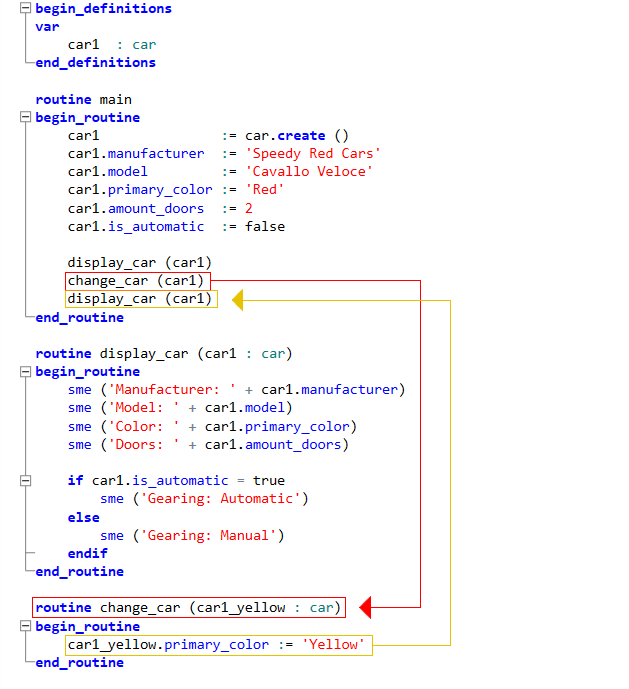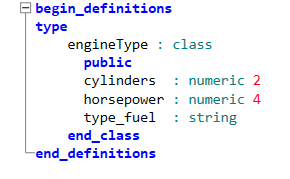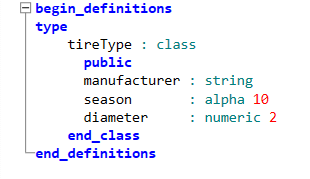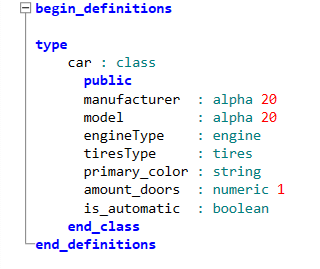Usage of Classes
In order to make use of a global class it is necessary to define it in the Type Class definition
first (Repository Tree > Types > Classes). Read how to do this on the Classes pages.
Example Usage
In this example we will use the following variables inside a class' definition to create a global class named car. A class can also be local and looks the same, but it is defined inside a Form, Report, Global Routine, or Web Service's definition.
type
car : class
public
manufacturer : alpha 20
model : alpha 20
primary_color : string
amount_doors : numeric 1
is_automatic : boolean
end_class
end_definitions
| Please note that a global class needs to be checked in using Revision Control before it can be used. Any changes made to the class are also required to be checked-in before they take effect. The latest checked-in version will always be used. |
The class is now ready to be used in Forms, Reports, Global Routines, and Web Services.
Class Usage
To start using the class, we will begin by defining a variable with the type of the class. We will then use this variable to create an instance (our first object) of the class.
The syntax to construct a class is as follows:
| <variable> := <class>.<create> () |
The following example shows what our code will look like:
var
car1 : car
end_definitions
routine main
begin_routine
car1 := car.create () // creates an instance of the class "car"
end_routine
The example below shows a full report that will also send multiple messages about all the car's details.
var
car1 : car
end_definitions
routine main
begin_routine
car1 := car.create ()
car1.manufacturer := 'Red Speedy Cars'
car1.model := 'Cavallo Veloce'
car1.primary_color := 'Red'
car1.amount_doors := 2
car1.is_automatic := false
display_car ()
end_routine
routine display_car
begin_routine
sme ('Manufacturer: ' + car1.manufacturer)
sme ('Model: ' + car1.model)
sme ('Color: ' + car1.primary_color)
sme ('Doors: ' + car1.amount_doors)
if car1.is_automatic = true
sme ('Gearing: Automatic')
else
sme ('Gearing: Manual')
endif
end_routine
It is also possible to clear an instance of a class (effectively deleting it) by assigning the special value null to it. The instance and its values will no longer be retrievable.
The syntax to clear an instance of a class is as follows:| <class-instance> := null |
Classes and Routines
The initial value given to a variable in an instance can also be changed at a later point in code. For example, the color red of a car object could be changed to become the color yellow instead.
In the following example, a routine was added to change the color of the variable "primary_color".
begin_routine
car1_yellow.primary_color := 'Yellow'
end_routine
Then we display the change made to the instance:
change_car (car1) // starts the routine to change the color
display_car (car1) // displays the "car1" instance after the change with the color yellow
After running the report the following result is displayed:

As you can see, the first result is the original car in the color red, the second result is the same car but in the color yellow, and all other values remain unchanged.
The newly created routine "change_car" uses a local variable named "car1_yellow". This variable points to the same place in memory as the instance "car1" and is displayed when the second "display_car" is called. The image below demonstrates a complete example of the report.

If we create a new instance inside the routine, this will not be displayed when "display_car" is called because this instance is local to the routine. The displayed car (car1) output would still be the original red car.
begin_routine
car1_yellow := car.create ()
car1_yellow.primary_color := 'Yellow'
end_routine
Routines can also create a new local instance of a class with empty values for the class' members through the use of the keyword var. To do so, include the keyword var inside the routine's parameter before defining the variable which is to become an instance of the class.
Example:
| routine <routine_name> (var <instance> : <class>) |
Then create a new instance of the class car.
Example code:
begin_routine
car1_yellow := car.create ()
car1_yellow.primary_color := 'Yellow'
end_routine
This assigns the color "Yellow" to the object "car1_yellow" and leaves all other values for each class member empty. It can therefore sometimes be useful to have a Class Create Routine that automatically assigns default values to class members upon creation of a new instance.
Nested Classes
Nested classes are classes that are present within another class.
The following images shows two classes, the class engineType and the class tiresType.


The two classes above are then nested inside the class car shown below.

However, it is not possible to make a class a member of itself, for example by making the class car a member of the class car. It is also not possible to make the main class a member of a nested class, for example by making class car a member of its nested class engineType.
The main class as well as the nested classes require an instance to be created to be able to make use of these nested classes.
The following example shows the usage of all three classes that we created. The class car is used as
the main class and the classes engineType and tireType are nested within. In the
second block of code you can see that our instance "car1" has values assigned to its engine and tires variables.
var
car1 : car
end_definitions
routine main
begin_routine
car1 := car.create ()
car1.engine := engineType.create ()
car1.tires := tireType.create ()
car1.manufacturer := 'Speedy Red Cars'
car1.model := 'Cavallo Veloce'
car1.primary_color := 'Red'
car1.amount_doors := 2
car1.is_automatic := false
car1.features(true)
car1.engine.cylinders := 8
car1.engine.horsepower := 750
car1.engine.type_fuel := 'Gas & Electric'
car1.tires.manufacturer := 'Slick & Grippy Co.'
car1.tires.diameter := 19
car1.tires.season := 'Summer'
display_car (car1)
end_routine
Class Functions
The following functions can be used in a class constructor:
|
Create () Returns a new empty class instance of the class constructor. Example syntax:
|
|
|
FromJson (<Json String>) Returns a class instance of the class
constructor filled with values from a Json String. Example syntax:
|
|
|
FromXml (<XML String>) Returns a class instance of the class constructor filled with values from an XML String. Example syntax:
|
The following functions can be used with a class instance:
|
ToJson () returns all the elements in the class instance as a Json String. Example syntax:
|
|
|
ToXml () returns all the elements in the class instance as an Xml String. Example syntax:
|
